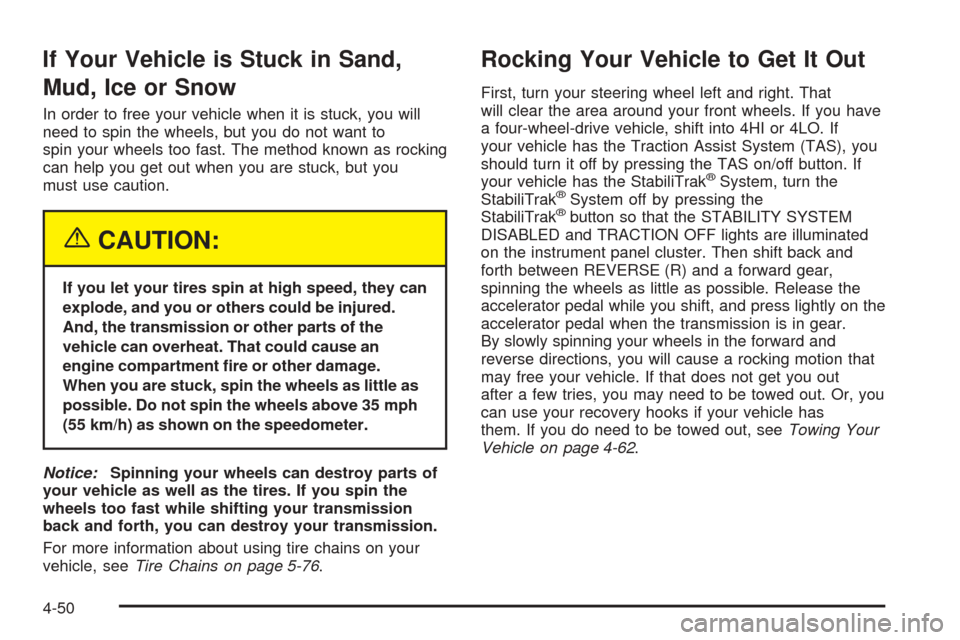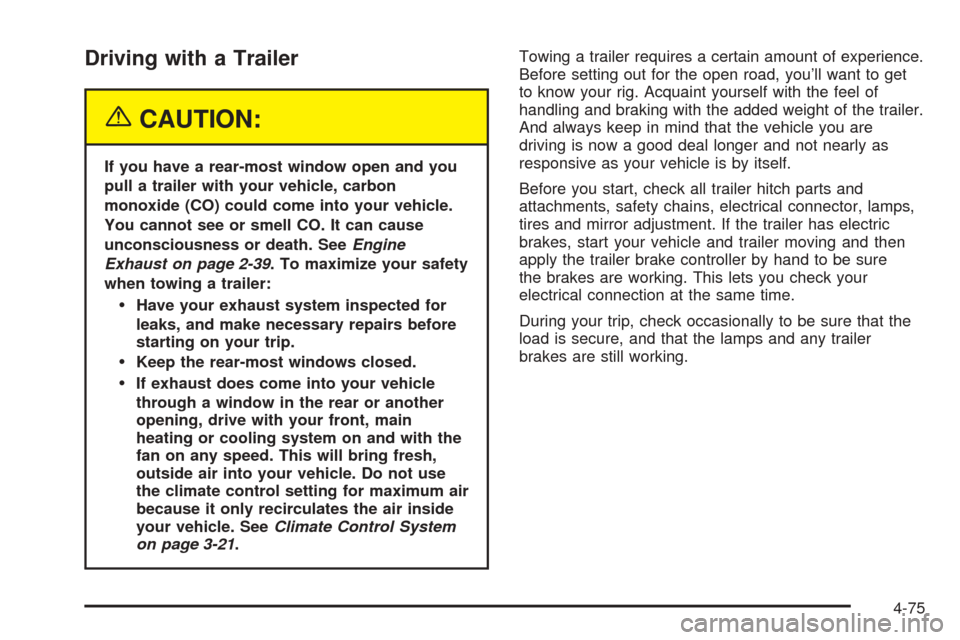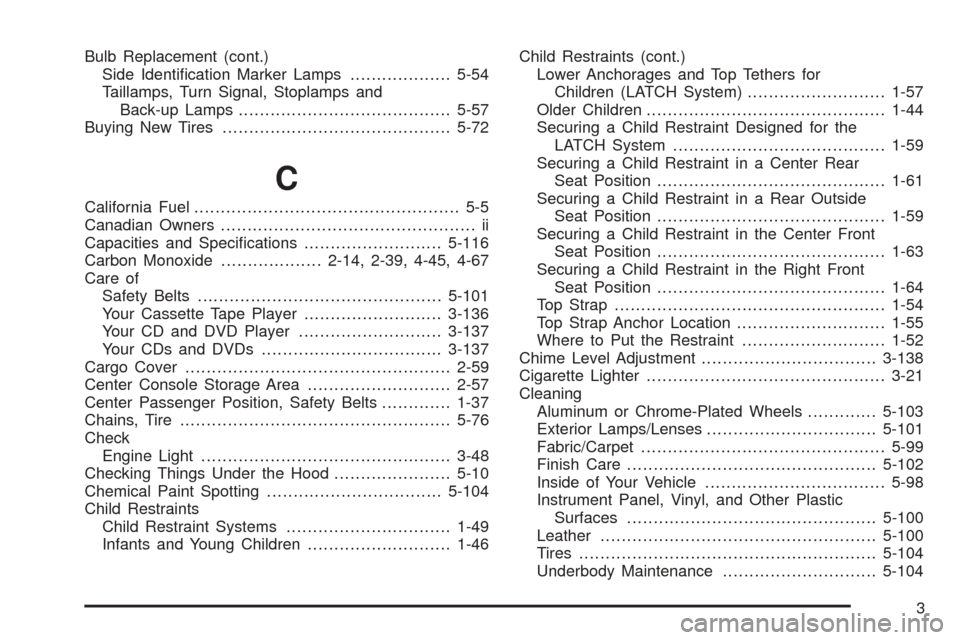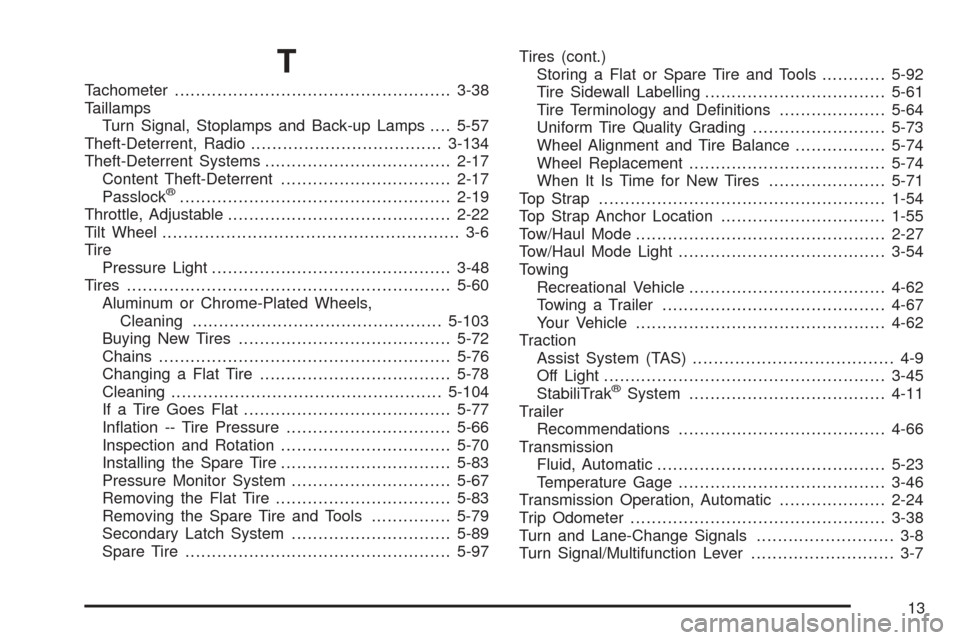2005 CHEVROLET SUBURBAN Tire chains
[x] Cancel search: Tire chainsPage 306 of 536

QUADRASTEER™
The QUADRASTEER™ System has a control and
diagnostic module that monitors and records current
system status and operational information.
If your vehicle is equipped with the 4-Wheel Steer
system, it has the ability to steer the vehicle with all
four wheels.
Once the 4-Wheel Steer mode is selected, it is
recommended to leave the vehicle in this mode at all
times, and during all driving and weather conditions.
You can select this mode at any speed, however, if you
are turning, the system will not engage until the turn
is complete.
The 4-Wheel Steer system is equipped with
three different driving modes:
2:Two-wheel steering
4:Four-wheel steering
_:Four-wheel steering with a trailer modeThe switch is located on the instrument panel.
2:In this mode, the vehicle will operate like any other
vehicle with two-wheel steering. If you want to use
2-wheel steer mode and your vehicle is not in this mode,
press the button until the 2 indicator, located to the
right of the 4-Wheel Steer button, lights up. If the
2 indicator is �ashing, you will have to center the
steering wheel by turning it to the left or right.
Your vehicle will return to 2 when the transmission is
shifted into NEUTRAL (N), for example when entering a
car wash.
If you want to use tire chains, the vehicle needs to be in
2-wheel steer mode. For more information seeTire
Chains on page 5-76.
4-16
Page 340 of 536

If Your Vehicle is Stuck in Sand,
Mud, Ice or Snow
In order to free your vehicle when it is stuck, you will
need to spin the wheels, but you do not want to
spin your wheels too fast. The method known as rocking
can help you get out when you are stuck, but you
must use caution.
{CAUTION:
If you let your tires spin at high speed, they can
explode, and you or others could be injured.
And, the transmission or other parts of the
vehicle can overheat. That could cause an
engine compartment �re or other damage.
When you are stuck, spin the wheels as little as
possible. Do not spin the wheels above 35 mph
(55 km/h) as shown on the speedometer.
Notice:Spinning your wheels can destroy parts of
your vehicle as well as the tires. If you spin the
wheels too fast while shifting your transmission
back and forth, you can destroy your transmission.
For more information about using tire chains on your
vehicle, seeTire Chains on page 5-76.
Rocking Your Vehicle to Get It Out
First, turn your steering wheel left and right. That
will clear the area around your front wheels. If you have
a four-wheel-drive vehicle, shift into 4HI or 4LO. If
your vehicle has the Traction Assist System (TAS), you
should turn it off by pressing the TAS on/off button. If
your vehicle has the StabiliTrak
®System, turn the
StabiliTrak®System off by pressing the
StabiliTrak®button so that the STABILITY SYSTEM
DISABLED and TRACTION OFF lights are illuminated
on the instrument panel cluster. Then shift back and
forth between REVERSE (R) and a forward gear,
spinning the wheels as little as possible. Release the
accelerator pedal while you shift, and press lightly on the
accelerator pedal when the transmission is in gear.
By slowly spinning your wheels in the forward and
reverse directions, you will cause a rocking motion that
may free your vehicle. If that does not get you out
after a few tries, you may need to be towed out. Or, you
can use your recovery hooks if your vehicle has
them. If you do need to be towed out, seeTowing Your
Vehicle on page 4-62.
4-50
Page 365 of 536

Driving with a Trailer
{CAUTION:
If you have a rear-most window open and you
pull a trailer with your vehicle, carbon
monoxide (CO) could come into your vehicle.
You cannot see or smell CO. It can cause
unconsciousness or death. SeeEngine
Exhaust on page 2-39. To maximize your safety
when towing a trailer:
Have your exhaust system inspected for
leaks, and make necessary repairs before
starting on your trip.
Keep the rear-most windows closed.
If exhaust does come into your vehicle
through a window in the rear or another
opening, drive with your front, main
heating or cooling system on and with the
fan on any speed. This will bring fresh,
outside air into your vehicle. Do not use
the climate control setting for maximum air
because it only recirculates the air inside
your vehicle. SeeClimate Control System
on page 3-21.Towing a trailer requires a certain amount of experience.
Before setting out for the open road, you’ll want to get
to know your rig. Acquaint yourself with the feel of
handling and braking with the added weight of the trailer.
And always keep in mind that the vehicle you are
driving is now a good deal longer and not nearly as
responsive as your vehicle is by itself.
Before you start, check all trailer hitch parts and
attachments, safety chains, electrical connector, lamps,
tires and mirror adjustment. If the trailer has electric
brakes, start your vehicle and trailer moving and then
apply the trailer brake controller by hand to be sure
the brakes are working. This lets you check your
electrical connection at the same time.
During your trip, check occasionally to be sure that the
load is secure, and that the lamps and any trailer
brakes are still working.
4-75
Page 376 of 536

Tires..............................................................5-60
Tire Sidewall Labelling...................................5-61
Tire Terminology and De�nitions.....................5-64
In�ation - Tire Pressure.................................5-66
Tire Pressure Monitor System.........................5-67
Tire Inspection and Rotation...........................5-70
When It Is Time for New Tires.......................5-71
Buying New Tires.........................................5-72
Uniform Tire Quality Grading..........................5-73
Wheel Alignment and Tire Balance..................5-74
Wheel Replacement......................................5-74
Tire Chains..................................................5-76
If a Tire Goes Flat........................................5-77
Changing a Flat Tire.....................................5-78
Removing the Spare Tire and Tools................5-79
Removing the Flat Tire and Installing the
Spare Tire................................................5-83
Secondary Latch System...............................5-89
Storing a Flat or Spare Tire and Tools............5-92
Spare Tire...................................................5-97
Appearance Care............................................5-97
Cleaning the Inside of Your Vehicle.................5-98
Fabric/Carpet...............................................5-99
Leather......................................................5-100
Instrument Panel, Vinyl, and Other Plastic
Surfaces.................................................5-100Care of Safety Belts....................................5-101
Weatherstrips.............................................5-101
Washing Your Vehicle..................................5-101
Cleaning Exterior Lamps/Lenses....................5-101
Finish Care................................................5-102
Windshield, Backglass, and Wiper Blades.......5-102
Aluminum or Chrome-Plated Wheels..............5-103
Tires.........................................................5-104
Sheet Metal Damage...................................5-104
Finish Damage...........................................5-104
Underbody Maintenance...............................5-104
Chemical Paint Spotting...............................5-104
Vehicle Care/Appearance Materials................5-105
Vehicle Identi�cation.....................................5-106
Vehicle Identi�cation Number (VIN)................5-106
Service Parts Identi�cation Label...................5-106
Electrical System..........................................5-107
Add-On Electrical Equipment.........................5-107
Windshield Wiper Fuses...............................5-107
Power Windows and Other Power Options......5-107
Fuses and Circuit Breakers..........................5-107
Instrument Panel Fuse Block........................5-108
Center Instrument Panel Fuse Block..............5-110
Underhood Fuse Block................................5-111
Capacities and Speci�cations........................5-116
Section 5 Service and Appearance Care
5-2
Page 450 of 536

Tire Chains
{CAUTION:
If your vehicle has P265/75R16, LT265/75R16,
P265/70R16 or P265/70R17 size tires, don’t use
tire chains. They can damage your vehicle
because there’s not enough clearance. Tire
chains used on a vehicle without the proper
amount of clearance can cause damage to the
brakes, suspension or other vehicle parts. The
area damaged by the tire chains could cause
you to lose control of your vehicle and you or
others may be injured in a crash.
Use another type of traction device only if its
manufacturer recommends it for use on your
vehicle and tire size combination and road
conditions. Follow that manufacturer’s
instructions. To help avoid damage to your
vehicle, drive slowly, readjust or remove the
device if it’s contacting your vehicle, and don’t
spin your wheels.
If you do �nd traction devices that will �t,
install them on the rear tires.Notice:If you have a tire size other than
P265/75R16, LT265/75R16, P265/70R16 or
P265/70R17 use tire chains only where legal
and only when you must. Use chains that are the
proper size for your tires. Install them on the
rear tires only.
Don’t use chains on the front tires.
Tighten them as tightly as possible with the ends
securely fastened. Drive slowly and follow the chain
manufacturer’s instructions. If you can hear the
chains contacting your vehicle, stop and retighten
them. If the contact continues, slow down until
it stops. Driving too fast or spinning the wheels with
chains on will damage your vehicle.
5-76
Page 525 of 536

Bulb Replacement (cont.)
Side Identi�cation Marker Lamps...................5-54
Taillamps, Turn Signal, Stoplamps and
Back-up Lamps........................................5-57
Buying New Tires...........................................5-72
C
California Fuel.................................................. 5-5
Canadian Owners................................................ ii
Capacities and Speci�cations..........................5-116
Carbon Monoxide...................2-14, 2-39, 4-45, 4-67
Care of
Safety Belts..............................................5-101
Your Cassette Tape Player..........................3-136
Your CD and DVD Player...........................3-137
Your CDs and DVDs..................................3-137
Cargo Cover..................................................2-59
Center Console Storage Area...........................2-57
Center Passenger Position, Safety Belts.............1-37
Chains, Tire...................................................5-76
Check
Engine Light...............................................3-48
Checking Things Under the Hood......................5-10
Chemical Paint Spotting.................................5-104
Child Restraints
Child Restraint Systems...............................1-49
Infants and Young Children...........................1-46Child Restraints (cont.)
Lower Anchorages and Top Tethers for
Children (LATCH System)..........................1-57
Older Children.............................................1-44
Securing a Child Restraint Designed for the
LATCH System........................................1-59
Securing a Child Restraint in a Center Rear
Seat Position...........................................1-61
Securing a Child Restraint in a Rear Outside
Seat Position...........................................1-59
Securing a Child Restraint in the Center Front
Seat Position...........................................1-63
Securing a Child Restraint in the Right Front
Seat Position...........................................1-64
Top Strap...................................................1-54
Top Strap Anchor Location............................1-55
Where to Put the Restraint...........................1-52
Chime Level Adjustment.................................3-138
Cigarette Lighter.............................................3-21
Cleaning
Aluminum or Chrome-Plated Wheels.............5-103
Exterior Lamps/Lenses................................5-101
Fabric/Carpet..............................................5-99
Finish Care...............................................5-102
Inside of Your Vehicle..................................5-98
Instrument Panel, Vinyl, and Other Plastic
Surfaces...............................................5-100
Leather....................................................5-100
Tires........................................................5-104
Underbody Maintenance.............................5-104
3
Page 535 of 536

T
Tachometer....................................................3-38
Taillamps
Turn Signal, Stoplamps and Back-up Lamps....5-57
Theft-Deterrent, Radio....................................3-134
Theft-Deterrent Systems...................................2-17
Content Theft-Deterrent................................2-17
Passlock
®...................................................2-19
Throttle, Adjustable..........................................2-22
Tilt Wheel........................................................ 3-6
Tire
Pressure Light.............................................3-48
Tires.............................................................5-60
Aluminum or Chrome-Plated Wheels,
Cleaning...............................................5-103
Buying New Tires........................................5-72
Chains.......................................................5-76
Changing a Flat Tire....................................5-78
Cleaning...................................................5-104
If a Tire Goes Flat.......................................5-77
In�ation -- Tire Pressure...............................5-66
Inspection and Rotation................................5-70
Installing the Spare Tire................................5-83
Pressure Monitor System..............................5-67
Removing the Flat Tire.................................5-83
Removing the Spare Tire and Tools...............5-79
Secondary Latch System..............................5-89
Spare Tire..................................................5-97Tires (cont.)
Storing a Flat or Spare Tire and Tools............5-92
Tire Sidewall Labelling..................................5-61
Tire Terminology and De�nitions....................5-64
Uniform Tire Quality Grading.........................5-73
Wheel Alignment and Tire Balance.................5-74
Wheel Replacement.....................................5-74
When It Is Time for New Tires......................5-71
Top Strap......................................................1-54
Top Strap Anchor Location...............................1-55
Tow/Haul Mode...............................................2-27
Tow/Haul Mode Light.......................................3-54
Towing
Recreational Vehicle.....................................4-62
Towing a Trailer..........................................4-67
Your Vehicle...............................................4-62
Traction
Assist System (TAS)...................................... 4-9
Off Light.....................................................3-45
StabiliTrak
®System.....................................4-11
Trailer
Recommendations.......................................4-66
Transmission
Fluid, Automatic...........................................5-23
Temperature Gage.......................................3-46
Transmission Operation, Automatic....................2-24
Trip Odometer................................................3-38
Turn and Lane-Change Signals.......................... 3-8
Turn Signal/Multifunction Lever........................... 3-7
13